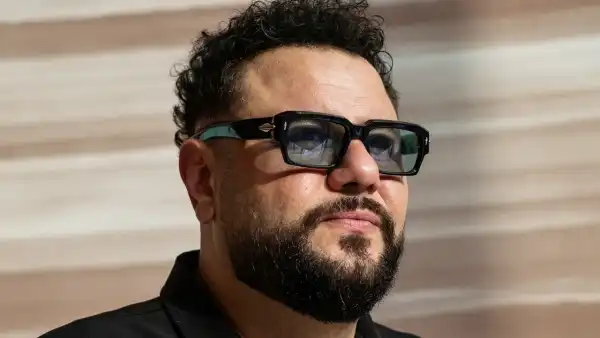
Halfway through the first act of Anna Deavere Smith’s new one-woman show, “Notes from the Field,” Smith, whose plays are made up of what she calls “portraits” of Americans, takes on the persona of the Reverend Jamal Bryant to deliver, word for word, the eulogy he gave at New Shiloh Baptist Church for Freddie Gray, the twenty-five-year-old man who died last year after being transported in a police van in Baltimore. By this point in the play, Smith has already played a handful of other people—she opens as Sherrilyn Ifill, the president of the N.A.A.C.P. Legal Defense Fund, and then becomes a young protester, and then the man who filmed Gray’s arrest on his cell phone—but here she takes the crowd to church.
Sometimes, to assume others’ identities, Smith changes blazers, hats, and shoes, but most of the characterization happens in her body and through her voice, which can mimic even the most idiosyncratic verbal tics. As Bryant, Smith bellows, letting her words crack and bounce around the rafters at an operatic volume. She gestures with a shaking hand toward the seats. There is no room in this scenario for passive watching. On the evening I attended, at the close of the sermon one person cried out “preach,” and then the rest of the crowd, tentative at first, followed suit; soon the entire audience was yelling. An older white woman sitting in front of me, wearing a brocade shawl, felt compelled to raise a fist.
Smith, who is sixty-six, discovered her gift for mimicry as a child, in Baltimore, where her mother was a schoolteacher and principal and her father a shopkeeper on Pennsylvania Avenue. She has credited her interest in depicting broad swaths of America partly to a road trip she took with four girlfriends to California in 1971, when she was twenty-one years old. As she wrote in her memoir “Talk to Me,” “We wanted to see America and to make sense, each in our own way, of what to do with all the breakage and promise that had been released through the antiwar movement, the assassinations of Martin Luther King and Bobby Kennedy, the beginning of the environmental movement, and the bra-burning, brief as it was, of the women’s movement.”
Smith has, for the past three decades, been working in a theatrical genre of her own invention, for which she has won a MacArthur “genius” grant, a Guggenheim fellowship, a Stanford professorship, and a number of artistic residencies. To create her solo symphonies, she travels across the country and abroad doing interviews, then edits the testimonials to a series of verbatim excerpts, and learns them. When she strings the monologues together, she does not offer any narration or editorial frame, preferring to leave gaps for the audience to fill in, puzzling out why these voices, and why in this order. Her first show in this vein was “Fires in the Mirror,” an exploration of the violent Crown Heights riots of 1991; her 1993 follow-up, “Twilight: Los Angeles, 1992,” dealt with those in Los Angeles. Smith rarely plays herself. In “Let Me Down Easy,” from 2009, which tackled the American health-care system, she played the cyclist Lance Armstrong, a New Orleans doctor after Katrina, and the former Texas governor Ann Richards.
Last week, on the kind of rainy morning that closely resembles an evening, Smith was visiting the Met Breuer on a day off from performing “Notes,” which opened earlier this week at Second Stage. She was attending the retrospective of the artist Kerry James Marshall, who has lived and worked on Chicago’s South Side for three decades, painting people at the Robert Taylor Homes public-housing complex, near his studio. The exhibition had not yet officially opened, and the galleries were eerily empty; Smith, too, was quiet and focussed, as if holding back the dynamism for which she is known onstage. She stood in front of a painting called “Sob, Sob,” in which a young woman sits near some stairs and a pastel-colored landing, the word “sob” floating above her head in comic-book type. As she looked at it, a natty man in a slim black suit walked into the gallery and introduced himself as Ian Alteveer, one of the curators of the retrospective; he remembered Smith from Stanford, where she taught and he was a student. Smith looked at him, too, in her focussed way, as if reading him.
“What does he mean by ‘mastry’?” Smith asked, referring to the title of the exhibition.
“Well, of course, it is a reference to the old masters,” Alteever said, prepared for the question, “and there are the historical implications of the word.” He also mentioned Marshall’s “Rhythm Mastr” lightboxes downstairs, taken from a graphic-novel project about two heroes who get their powers from African objects. “Kerry always says, more than anything: ‘I want my career to be a thoughtful one.’ ” Smith asked him to repeat the phrase.
“A thoughtful one,” she repeated back. “That’s so nice.”
Smith is known for the range of characters she plays onstage and on television, in roles like the national-security adviser Nancy McNally, on “The West Wing,” and Gloria Akalitus, on “Nurse Jackie.” Still, she said, she does not “do” other people, nor is she an impersonator. In discussing some of the characters she plays in her latest production—Niya Kenny, a teen-age girl (fidgety feet, a nervous biting of her cheek) who stood up to a police officer after he violently handcuffed her for refusing her teacher’s order to put away her cell phone; a female prison inmate whose only object of affection is the dog she trains (slumped over, speaking almost in a whisper)—Smith also objected to the idea that she “gives voice” to people who might not otherwise be heard. “If anything, they give me a voice,” she said, when we were downstairs in the airy museum café. “Anybody can speak for themselves, and they always could.”
“Notes” is about the school-to-prison pipeline that has created and perpetuated cycles of violence and inequality in America. It was initially just a staged reading based on interviews she had conducted in Northern California, which Smith performed at the Yerba Buena Center for the Arts, and which was followed by a town-hall discussion in which the audience and students could respond. Almost immediately after the first performance, however, protests began in Ferguson. “Then I ended up in Baltimore the following May, right after the riot, and that’s my home town,” she said. Next thing she knew, election season had begun, and she felt she had no choice but to get to work and mount the show as a full production, based on interviews conducted all over the country. “I think if I had not made this decision, I would have been really heartsick. Like Sherrilyn Ifill says, her father would make them watch everything about the civil-rights moment, and she was like, ‘Darn it, I missed it.’ I would be in a darn-it-I-missed-it place.”
Smith ordered a coffee and expressed gratitude that we were in a quiet spot. Because her voice carries the entire show, and she has no replacement to fall back on, she spends most of her hours during a theatrical run not speaking. “I live a monkish existence,” she said. “You wait and see. Go to any coffee shop, any café, anywhere in New York. It’s loud—everywhere. So I can’t go. I can’t shout.”
Smith has invented her own system for making theatre, but at the same time she is keenly aware that her output must fit into the existing one. Like many people, she said she struggles “to attract younger, more diverse audiences.”But she takes a pride in transforming not just herself but the audience, too. She especially likes the call-and-response part of the play, which helps her maintain the momentum.“The guy who mixes the sound on the mike promised me that, if they don’t say ‘no peace’ after I say ‘no justice,’ he will,” Smith said. “But it has never been so bad that they don’t say ‘no peace.’ ”
She told me about a friend of Gray’s who came to see “Notes” in Baltimore and who, afterward, “was inconsolable. It was the first time he had been able to grieve.” On the night I saw “Notes” in Manhattan, the woman next to me also wept when Smith gave Bryant’s eulogy. “That was a good show,” she said of the performance, which had been on a Wednesday. “There were a lot of young people there.” She wants young people to see her plays, not just those from Dalton, the tony private school near the Met Breuer—although, she concedes, “those kids get to come to my shows, and they do my shows. I heard that Dalton put on ‘Twilight: Los Angeles.’ I would have loved to have seen that.” She seemed genuinely delighted at the thought.
In an earlier version of “Notes,” Smith played the writer James Baldwin. “I was thinking about that painting that said ‘IF THEY COME IN THE MORNING,’ ” she said, referring to one of Marshall’s canvases, in which the phrase is written in bold red letters on a clashing red background. “That one really blew my mind. That painting is, of course, a reference to a letter that James Baldwin wrote to Angela Davis when she was in prison, and also the title of the book she wrote,” Smith said, recalling the correspondence, from 1970, in which Baldwin told the imprisoned Davis that he and others must “fight for your life as though it were our own—which it is—and render impassable with our bodies the corridor to the gas chamber. For, if they take you in the morning, they will be coming for us that night.” Smith remembered how she spent two summers studying Davis’s every word so that she could play her in “Fires in the Mirror.” “I know from researching her and her trial, back in the nineties, that they really did almost kill her, because they kept going back and forth in California about the death penalty.”
“But, first of all, it was just the beauty of [Marshall’s] banner,” she went on. “It reminds me—and I don’t know the origin of this reference I am going to make, but I think about it a lot—of the blood-stained banner of struggle, which is apparently an old Christian hymn. James Cone, who is a great theologian, and who is someone I have performed, and Cornel West, who I also performed, both use that expression: the blood-stained banner of struggle.” It struck me that one of the reasons Smith, in all her quietness, is such a formidable presence is that when you talk to her you are talking to everyone she has ever played. She surrounds herself with powerful company.
“I’m always following some odd impulse,” she said. “Like, this summer, I had to listen to every version of ‘A Whiter Shade of Pale,’ which led me to an album by a saxophonist called King Curtis and an organist named Billy Preston. They were the band for Aretha Franklin at the Fillmore. That’s the tangent I am on right now.”
Smith loves the photography of Mary Ellen Mark, and repeated Mark’s line about the camera giving her “the necessary distance” to get close to strangers, noting that this is not dissimilar to what she tries to do in her plays. Last summer, Smith went to see the Cindy Sherman retrospective at the Broad Museum, in Los Angeles. “As you can imagine, I’m inspired by her work,” she said, of Sherman’s fictional self-portraits. All the same, the exhibition left her feeling melancholy; the Marshall retrospective had made her feel the same way. She identified with his ambition, she said, and envied that he had the means to gather all of his work in one place for people to admire. “I do think that visual artists have a certain advantage that we in the theatre don’t really have,” she said. “It could be something about the fact that with visual art you can go back, you can study something right in front of you.”
She went on, “But what struck me about ‘Mastry’ was that word. I’m thinking about that. The obvious diligence of it. The extraordinary ambition. I will go back and see it again.”
Sourse: newyorker.com






